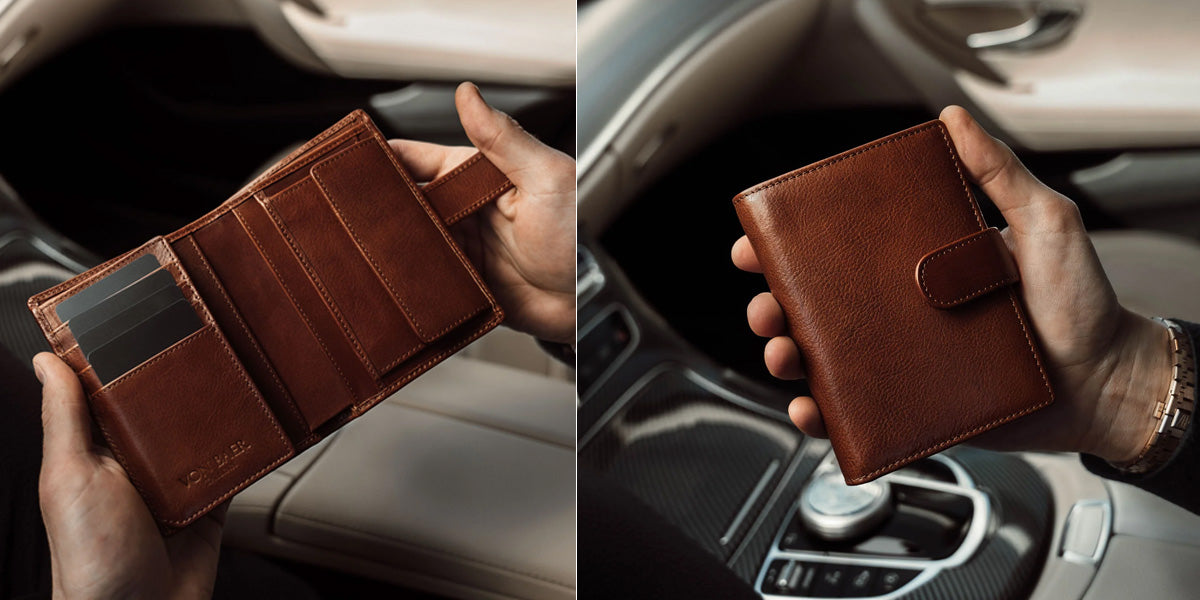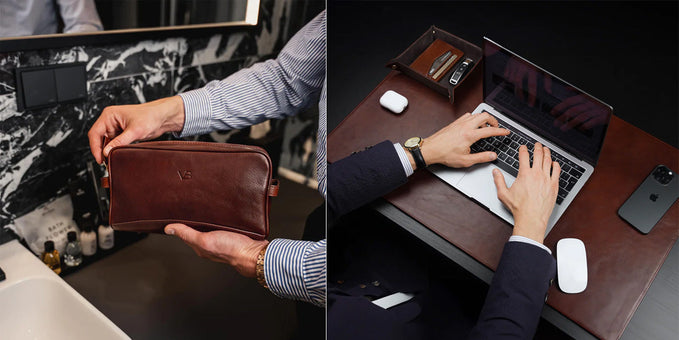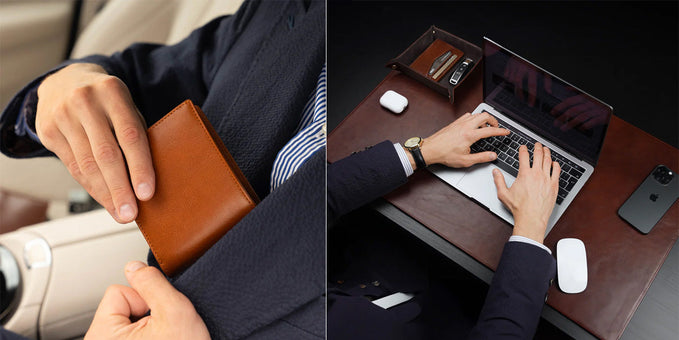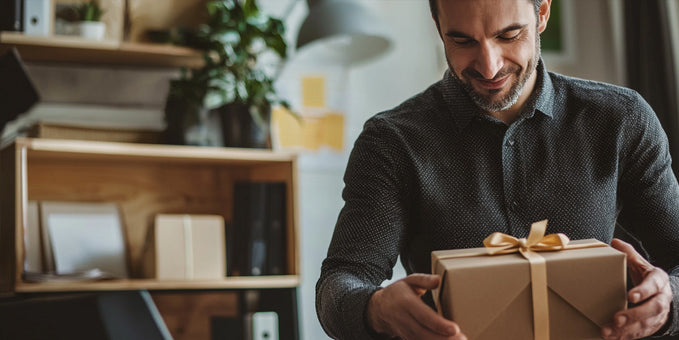Do Leather Wallets Stretch?

When you buy a high-quality wallet, the tightness that you see at first is usually a sign of its excellent craftsmanship and design, as opposed to a problem.
The snug fit can be concerning, especially when you attempt to add a few bills or cards to it without force, but the resistance is both normal and intentional.
Read on to find out why this occurs, what it says about the construction of the material, and how you can achieve the right balance between firmness and flexibility.
The Nature of Leather: Why Does Tightness Reflect Quality?
Real leather is an organic material that retains specific properties from its natural state.
The material has a natural elasticity, which enables it to adapt and adjust in a different way than synthetic materials.
The initial tightness occurs because the natural collagen fibers are holding their shape.
The densely packed fibers are essential as they give the wallet strong shape retention and durability to protect your cards - otherwise they would go loose and your cards would fall out!
However, this does vary depending on the type of leather:
- Full-grain vegetable-tanned leather—the highest quality—is dense and minimally processed, meaning it takes longer to adapt but does so with integrity, maintaining its structure while softening elegantly.
- Top-grain leather, while durable, stretches faster because of its thinner composition and protective coating.
Expert Tip: For a premium choice, full-grain vegetable-tanned leather offers the best balance of durability and adaptability over time, making it worth the investment for those seeking a product that ages with distinction - this is what we use in all Von Baer wallets.
Well-made wallets are designed to feel snug at first.
The tight fit cuts the risk of overstretching and means the structure of your wallet can be maintained even after years of usage.
The leather is designed to mold to the specific number of items that you're carrying and enhance its security and tactic feel so your cards are securely kept in place.
Key takeaway: The snugness of your wallet is an intentional and deliberate design choice. It promotes longevity and gives you a personalized fit over time.
Speeding up the Break-In Process Without Damaging It
Breaking in leather doesn’t require harsh methods—often, a bit of patience and gradual use is the best approach.
Trying to “force” the material to stretch faster, especially with water-based methods, can lead to stiffness or discoloration.
However, you can encourage the leather to conform to your needs without compromising its quality. Here’s how:
- Use gradual loading: For the first few weeks, begin with only your essential items. Add additional cards and bills over time, allowing the leather to adjust to the increasing load. This gradual approach reduces the initial pressure and gives the material time to adapt..
- Use body heat: Carry your wallet in an inside pocket that's close to your body. If you follow this method, the warmth will soften the fiber naturally, making the leather more pliable. Do you wear a jacket during the daytime? If so, placing your wallet inside the inner breast pocket will enable you to blend mild pressure with warmth.
- Use natural materials to shape slots: Inserting a piece of cardboard or folded paper in each card slot overnight can encourage a gentle stretch without straining the leather.
- Pressure and shape material lightly: Gently press on the card slots with your thumbs, but don't bend or fold. This will encourage a controlled stretch. Targeted manipulation can loosen the fibers without putting the stitching under stress.
Avoid Quick-Fix Methods: Although you may be tempted to soften the leather with oils or water, this can actually cause permanent damage. It can weaken the seams and warp the material. Enable the process to unfold with care. Guide the break-in period, but don't rush it.
Key takeaway: Gradual, thoughtful handling will ensure that the leather stretches where you need it and maximize durability and comfort.
How Your Leather Wallet Adjusts: The Science of Stretching
When your leather wallet is in use, a number of factors work alongside each other to gradually loosen its fibers.
The process is driven by the way that the leather reacts to pressure, temperature, and natural oils.
Each time you use your wallet, the warmth from your hands combines with your skin's oils to soften the material and reduce its rigidity.
Over time, the fibers will adjust both to the pressure and contours of the cards and cash it's used to store.
How Micro-Stretching Works
When your cards are inserted and removed repeatedly, the material is essentially being micro-stretched.
Leather will expand at these pressure points, with the wallet specifically forming in line with your habits. Eventually, you will receive a feel that is customized to your needs.
This is similar to the way that leather watch straps gradually conform to the wrist. Although the flexibility is not immediate, it will build up in areas where stress and movement are at their highest. This gradual adaptation reflects the quality of the material.
Key takeaway: The leather will adapt in response to the way that you handle it, giving you a fit that is suited to your unique habits and lifestyle.
Preventing Overstretching: Keeping Your Wallet’s Shape
Leather can only stretch to a certain extent before irreversible damage occurs.
Overloading a wallet with cards and overstuffing it beyond its intended capacity weakens the fibers, resulting in a loose, worn-out look.
Avoiding overstretching maintains both appearance and structure, extending the item’s life.
Here are expert-level strategies to keep your accessory in shape:
- Limit unnecessary items: Rather than using your wallet as a catch-all for receipts and extra cards, aim for an intentional, streamlined approach. Limit it to essential items only, reducing pressure on the leather.
- Rotate frequently used cards: By alternating the placement of frequently used cards, you avoid repeated strain on the same area, allowing each section to adapt evenly. This technique minimizes “hot spots” or weak areas that might stretch more than others.
- Consider additional storage options: If you find yourself regularly carrying more items than this accessory can comfortably hold, try a secondary option for specific situations, such as a slim cardholder or a separate money clip for cash-heavy days.
- Expert Tip: When inserting multiple cards in the same slot, place a thin piece of parchment paper or fabric between them to reduce friction, which helps prevent premature wear in the slot.
Takeaway: Keeping your contents to a minimum and rotating placement preserves both function and appearance.
You might be interested in these related guides:
Long-Term Care for Your Leather Wallet

Whilst your wallet is breaking in, maintaining it well will become vital if you want to preserve its condition and shape.
Leather is an organic material that reacts to its environment. Its care routine must be as intentional as its initial break-in.
The right level of care will extend the life of your wallet and help you retain its aesthetic appeal at the same time.
Routine Maintenance Advice:
- Use a high-quality leather conditioner: Apply a conditioner that is specifically formulated for leather goods (like this one) every few months in order to keep the material soft and prevent cracking. Another great thing about conditioning is that it will maintain the leather's ability to stretch without it losing strength, so the snug fit it has developed can be preserved.
- Limit exposure to extreme conditions: As leather is so sensitive to heat and moisture, you'll need to avoid leaving it in particularly humid environments or direct sunlight for long periods of time. These environments can discolor or warp your wallet. When you're not using your wallet, be sure to keep it in a soft, breathable pouch. This will protect it from the elements.
- Don't overstuff the wallet: Although the wallet's capacity may feel flexible after it's been broken in, pushing it beyond its limit will cause deformities. Don't forget that leather has a threshold. If you fill it beyond this point, the structure can become compromised. Permanent changes, including stressed seams and misshapen slots, may occur due to overstuffing.
Key takeaway: Consistent, mindful maintenance will ensure that your wallet retains its form and becomes a timeless accessory.
We have a full post on cleaning your wallet here.
Recognizing Quality Leather and Its Benefits Over Time
Choosing quality pays off in the long run.
Not only does it stretch and mold gracefully, but it also develops a patina, which is the soft sheen that high-quality leather acquires with regular handling.
The patina adds a rich depth to the material’s appearance, making it uniquely yours.
Different types of leather affect how it will age:
- Full-grain leather: Known for its durability and natural imperfections, it forms a deep patina with use, offering an authentic and classic look.
- Vegetable-tanned leather: This type is tanned using natural ingredients and darkens beautifully over time, with the patina enhancing the natural tones.
Recognizing quality isn’t just about the look—it’s about function. High-quality options resist scratching, fading, and cracking more effectively than lower-quality materials, making them a worthwhile investment.
- Expert Tip: Look for a wallet with reinforced stitching, as quality leather with double or cross-stitching holds its shape longer, especially in high-stress areas like corners and edges.
See our full post on the best leather for wallets here.
Takeaway: A premium leather wallet not only improves with age but becomes a reflection of your lifestyle and daily interactions.

Author: Igor Monte
Igor Monte is the co-founder of Von Baer. He's an expert in all things premium leather, from being an end-user right up to the design and manufacturing process. His inside knowledge will help you choose the best leather product for you.
We strive for the highest editorial standards, and to only publish accurate information on our website.
Leave a Comment
Your email address will not be published.









